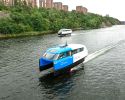New concept improves pilotage

To strengthen cooperation between maritime pilots and ship officers, a new working method has been developed as part of a research project funded by the Swedish Transport Administration. By using a shared, detailed passage plan, both collaboration and communication on board are improved. The aim is to enhance maritime safety.
The marine insurance company The Swedish Club reported in 2020 that a pilot was on board in 53% of the groundings they handled between 2014 and 2018. This is not unusual. Accident investigation boards around the world – in the U.S., Australia, and the U.K., for example – have pointed out the same pattern for years: ship and pilot passage plans often differ in detail, causing uncertainty on the bridge and leading officers to take a passive role instead of actively participating in navigation and supporting the pilot all the way to the berth.
“We reviewed several accident reports involving pilots and found that a common contributing factor is the lack of a shared passage plan. Often, the ship’s plan is outdated and lacks detail, or a thorough Master Pilot Exchange hasn’t taken place,” says Isabella Ågren, Human Factors specialist at MTO Safety and one of the authors of the report On the Right Course – Building Resilient Navigation, which summarizes the research project of the same name.
A major issue with the Master Pilot Exchange – the process where the captain and pilot share information and plan the inbound navigation – is that it typically happens under time pressure.
“Usually, it’s just a matter of minutes. The pilot comes aboard, greets the crew, runs through the essentials quickly, takes over command, and gives a brief update during the approach – if anyone is even listening. The officers often remain passive because they’re not familiar with the plan,” says Magnus Anderson, consultant and pilot, who also worked on the project.
This means the entire operation rests on one person, increasing the risk of what’s known in the human factors field as ‘single person error’. But that’s about to change. During the two-year project, a concept was developed involving a detailed passage plan that is shared before pilotage begins, allowing officers and pilots to work from a shared mental model. The concept is based on methods already in successful use in countries like New Zealand and Australia.
“If more than one person is actively involved and aware of each step in the plan, the system becomes safer and more resilient to deviations. It increases the chance of timely interventions – the ability to detect and act on deviations early. Planned changes or route adjustments can also be explained in advance, reducing the risk of misunderstandings,” says Isabella Ågren.
“The idea is for us to speak up the moment something deviates. Both the pilot and crew should ‘think aloud’ – a silent bridge during a port approach is not ideal. Thoughts, ideas, and observations need to be shared and confirmed continuously,” adds Magnus Anderson.
The concept was developed in collaboration with four pilots who participated in both a pre-study and post-study, at pilot stations in Helsingborg and Norrköping/Oxelösund. The pilots used the concept for eight months.
“We’ve used two tools: one that analyzes ship movements in the fairway and helps generate the passage plan, and one that sends the plan as a PDF with route and fairway images to the ship,” explains Magnus Anderson.
After the trial period, a follow-up study was conducted to measure impact. The results speak for themselves: working with a shared passage plan not only improves safety but also leads to clearer communication on board. It supports the development of a shared mental model – a key to safer navigation.
The project report ends with several recommendations, including that the concept should be implemented step by step. The first step is to create basic passage plans and make them accessible, for instance via the Swedish Maritime Administration’s website. The focus should be on getting started – not on perfection. From there, routines for distribution can be established, and the content of the plans gradually refined. One good test area is the Öresund Strait, where the concept has already been trialed with promising results.
The report On the Right Course – Building Resilient Navigation was written by Isabella Ågren, Magnus Anderson, and Lena Kecklund.
-
 Ny studie: Eldrivna pendelbåtar kan effektivisera Stockholms kollektivtrafik
Ny studie: Eldrivna pendelbåtar kan effektivisera Stockholms kollektivtrafik -
 EU: Sjöfartens utsläpp ökar
EU: Sjöfartens utsläpp ökar -
 Sociala relationer påverkar val av bränsle
Sociala relationer påverkar val av bränsle -
 Sjöfartens omställning kräver ”mjukare” påtryckningar
Sjöfartens omställning kräver ”mjukare” påtryckningar -
 Hon hade avtalad tid med Kapten ynkrygg
Hon hade avtalad tid med Kapten ynkrygg -
 Lighthouse omvärldsanalys 2025 – osäkerhet och tullar präglar sjöfarten
Lighthouse omvärldsanalys 2025 – osäkerhet och tullar präglar sjöfarten -
 Se seminariet Shipping in the Marine Environment
Se seminariet Shipping in the Marine Environment -
 Vad betyder egentligen de 90 procenten?
Vad betyder egentligen de 90 procenten? -
 Hålla där...
Hålla där... -
 Ny rapport: Klimatförändringarna ett hot mot de flesta större hamnar i världen
Ny rapport: Klimatförändringarna ett hot mot de flesta större hamnar i världen

